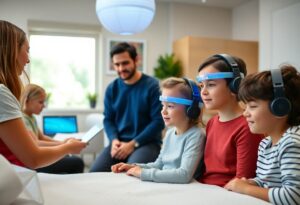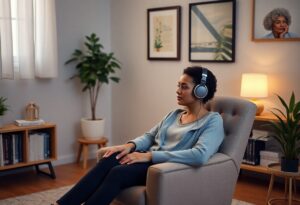Over recent years, neurofeedback has emerged as a promising approach to help children with learning disabilities improve their cognitive functioning and emotional well-being. By harnessing the power of brainwave training, you can witness significant enhancements in your child’s ability to focus, learn, and thrive in a school setting. This innovative technique not only targets the underlying neurological issues but also fosters a sense of empowerment in your child. For more insights, check out How Neurofeedback Improves Your Child’s Mental Health.
Key Takeaways:
- Improved Focus: Neurofeedback helps children with learning disabilities enhance their attention span, allowing them to concentrate better in classroom settings.
- Emotional Regulation: Through neurofeedback, children can learn to manage their emotions more effectively, leading to reduced anxiety and increased confidence in their abilities.
- Customized Training: Neurofeedback programs are tailored to each child’s specific needs, providing targeted support that addresses their unique challenges in learning.
Understanding Learning Disabilities
The journey toward understanding learning disabilities begins with recognizing their significance. You might wonder what precisely constitutes a learning disability and how it manifests in children today.
Definition and Types
The definition of learning disabilities varies, but they generally refer to a range of neurodevelopmental disorders that affect how a child processes information. These disorders can be organized into several types:
- Reading disabilities (Dyslexia)
- Mathematics disabilities (Dyscalculia)
- Written language disabilities (Dysgraphia)
- Nonverbal learning disabilities
- Processing disorders
The distinctions matter since each type of learning disability can present unique challenges in school and beyond.
Causes and Risk Factors
Any insight into the causes of learning disabilities reveals a combination of genetic, environmental, and neurological factors. Researchers have identified several key contributors:
- Genetic predisposition
- Brain structure and function variations
- Premature birth or low birth weight
- Exposure to toxins during pregnancy
- Family history of learning disabilities
The complexity of these factors often requires a multi-faceted approach to support your child.
But understanding the causes is necessary for providing comprehensive support. Factors like early childhood experiences, socioeconomic status, and access to quality education can influence your child’s development and learning capabilities. Addressing these risks may help mitigate their impacts on learning disabilities.
- Involvement of family in learning processes
- Access to special education resources
- Supportive learning environments
- Regular communication with educators
- Utilizing technology and tools designed for learning differences
The proactive engagement of your support systems can make a substantial difference in your child’s learning journey.
Impact on Development and Learning
On exploring the impact of learning disabilities, you’ll find that they can interfere with your child’s academic achievements and self-esteem.
A child with a learning disability might struggle with reading, writing, or math, which can lead to feelings of frustration and isolation. The effects often extend beyond academics, impacting their social skills, emotional well-being, and overall development. You can empower your child by recognizing these challenges and seeking effective interventions.
Neurofeedback: An Overview
One of the most innovative approaches to supporting children with learning disabilities is neurofeedback, a technique that helps you enhance brain function through real-time feedback on brain activity.
What is Neurofeedback?
At its core, neurofeedback is a type of biofeedback that enables you to train your brain by providing information about its activity. This is achieved using sensors that measure brainwaves, helping you understand how to modify your mental states for improved focus, relaxation, or performance.
The Science Behind Neurofeedback
On a scientific level, neurofeedback is based on the principle of operant conditioning, where you learn through reinforcement. By receiving visual or auditory feedback connected to your brain activity, you can develop greater awareness of your cognitive patterns and ultimately reshape them.
Even though it may sound complex, researchers have found that neurofeedback can lead to measurable changes in brainwave patterns. Studies show that through repeated training, you can improve specific brain functions and behaviors, particularly those related to attention, impulse control, and emotional regulation—necessary skills for children with learning disabilities.
Common Neurofeedback Techniques
Behind the variety of applications, several common techniques exist within neurofeedback, including classic EEG neurofeedback, Alpha/Theta protocols, and more advanced approaches like LENS (Low Energy Neurofeedback System). Each method caters to various needs and goals.
It’s important to understand that different neurofeedback techniques target specific brainwave patterns. For example, while EEG neurofeedback may focus on increasing alpha waves for relaxation, Alpha/Theta training aims to access deeper states of mindfulness, which can significantly aid children who struggle with anxiety or focus.

The Connection between Neurofeedback and Learning Disabilities
Your understanding of neurofeedback can considerably enhance your approach to supporting children with learning disabilities. By improving cognitive and emotional functioning, neurofeedback offers a unique avenue for growth and development. It addresses various challenges faced by children, allowing them to achieve greater academic and social success.
How Neurofeedback Works on Cognitive Functioning
Before delving into the benefits, it’s crucial to understand how neurofeedback impacts cognitive functioning. Neurofeedback involves training the brain to develop better patterns of activity, which can lead to improvements in attention, memory, and information processing. By receiving real-time feedback on brain activity, children can learn to regulate their brain states, which can be particularly beneficial for those facing learning disabilities.
Neurofeedback’s Role in Emotional Regulation
At the heart of many learning disabilities often lies a struggle with emotional regulation. Neurofeedback helps children recognize and modify their emotional responses by promoting a state of calm and focus. This ability to self-regulate can lead to a decrease in anxiety and frustration, ultimately creating a more conducive learning environment.
But nurturing emotional regulation through neurofeedback does more than just improve mood; it fosters resilience in children. When they encounter challenges in learning, being able to navigate their emotional responses empowers them to persevere. Furthermore, building emotional intelligence can enhance social interactions, leading to better relationships with peers and teachers alike.
Evidence of Effectiveness in Children
Across various studies, neurofeedback has demonstrated considerable effectiveness in children with learning disabilities. Research shows that children who engage in neurofeedback training often display significant improvements in attention, behavior, and academic performance.
Neurofeedback has been scrutinized across multiple peer-reviewed studies, revealing its potential to create lasting change in children with learning disabilities. Many participants report enhanced focus, decreased impulsivity, and improved academic outcomes. These findings underscore neurofeedback’s significance as a practical intervention, providing you with confidence in recommending this approach for children facing educational challenges.
Benefits of Neurofeedback for Children with Learning Disabilities
Not only does neurofeedback provide immediate feedback on your child’s brain activity, but it also helps improve various cognitive and emotional functions necessary for learning. By training the brain to recognize and adjust its activity patterns, your child can experience significant benefits tailored to their unique needs.
Improved Attention and Focus
Between the distractions of everyday life and the challenges posed by learning disabilities, maintaining attention can be especially difficult for your child. Neurofeedback facilitates the development of sustained focus by training their brain to enhance attentional resources. As a result, your child may find it easier to engage fully in their studies and daily activities.
Enhanced Memory and Retention
Memory plays a vital role in your child’s learning journey. By participating in neurofeedback, your child can benefit from improved memory retention and recall, making it easier for them to absorb new information. This kind of training reinforces the neural pathways responsible for memory, leading to a more efficient learning process.
Attention to memory aspects through neurofeedback has been shown to help your child better retain what they learn in the classroom. More efficient memory encoding allows them to build connections between concepts, enabling deeper understanding and improved academic performance over time. This sustained engagement with material can help mitigate the effects of learning disabilities that often hinder memory acquisition.
Emotional and Behavioral Stability
About 70% of children with learning disabilities also face emotional and behavioral challenges. Through neurofeedback, your child can learn to regulate their emotions and behaviors more effectively. This training fosters a sense of stability, enabling them to better cope with stress, frustration, and impulsivity.
Plus, emotional regulation is necessary for your child’s overall well-being and academic success. Neurofeedback equips them with the tools they need to manage their feelings and reactions in various situations. This increased emotional intelligence can lead to better social interactions and a more positive learning environment, ultimately enhancing your child’s educational experience.

The Process of Neurofeedback Therapy
Many parents are curious about how neurofeedback therapy can assist their children with learning disabilities. The process is structured to ensure individualized care and effective outcomes, which begins with a comprehensive assessment and tailored treatment sessions.
Initial Assessment and Diagnosis
About the initial assessment, a certified neurofeedback practitioner evaluates your child’s unique neurological patterns through various tests. This process often includes brain mapping, allowing the therapist to pinpoint specific areas that may be underactive or overactive, which could contribute to learning challenges.
Treatment Sessions and Protocols
The treatment sessions follow a standardized protocol tailored to your child’s specific needs. Each session typically lasts about 30 to 60 minutes, during which your child engages with interactive games or visuals while their brain activity is monitored.
Sessions aim to reinforce positive brainwave patterns and gradually retrain the brain to improve focus, behavior, and learning capabilities. By using reinforcement strategies, the therapist encourages your child to achieve desired brain functioning, effectively making each session a step towards enhancing cognitive abilities.
Monitoring Progress and Outcomes
At the end of each treatment cycle, you will receive a comprehensive update on your child’s progress. This allows you to stay informed about improvements and any necessary adjustments to the treatment plan.
Consequently, regular monitoring helps to optimize outcomes and ensure the therapy remains aligned with your child’s evolving needs. Ongoing assessments not only provide valuable feedback but also motivate your child by showcasing their advancements and successful milestones throughout the neurofeedback journey.
Addressing Common Concerns and Misconceptions
Despite the growing interest in neurofeedback for children with learning disabilities, several concerns and misconceptions remain. By addressing these, you can make more informed decisions about this therapy.
Safety and Side Effects of Neurofeedback
Around neurofeedback, parents often worry about its safety and potential side effects. Fortunately, research indicates that neurofeedback is a non-invasive method with minimal risks when conducted by certified professionals. Most children experience little to no side effects, making it a safe option for learning enhancement.
Duration and Commitment Required
Above all, the duration and commitment required for neurofeedback can be a concern for many families. Typically, a full course may involve several sessions over weeks or months, necessitating consistent participation to achieve the desired outcomes.
Concerns about time commitment are valid, as engaging in regular training sessions is important for progress. Most programs require at least 20 to 40 sessions, depending on your child’s needs and goals. By integrating neurofeedback into your weekly routine, you can help your child develop better cognitive skills gradually, making the time investment worthwhile.
Comparing Neurofeedback with Traditional Therapies
Side by side, neurofeedback and traditional therapies differ significantly in their approaches. Below is a comparative overview of both methods:
Comparison of Neurofeedback and Traditional Therapies
| Neurofeedback | Traditional Therapies |
|---|---|
| Non-invasive, focuses on brain function | Varied approaches, including behavioral interventions |
| Personalized training based on brain activity | Standardized approaches, less individualized |
| May promote autonomy and self-regulation | Often depends on direct oversight from the therapist |
Consequently, understanding these differences can help you evaluate which method might be more suitable for your child. Neurofeedback offers a unique, brain-focused perspective that can complement traditional therapies rather than replace them. This multifaceted approach can lead to improved outcomes for your child’s learning challenges.
Future Directions and Research in Neurofeedback
Keep an eye on the exciting developments happening in the field of neurofeedback. As researchers continue to explore innovative techniques, emerging technologies are transforming how neurofeedback is delivered and personalized for children with learning disabilities. Advancements in brain imaging, portable devices, and interactive software promise to make neurofeedback more accessible and effective for a wider audience.
Innovations in Neurofeedback Technology
Along with technological advancements, new platforms are being developed to facilitate real-time data collection and feedback, enabling you to monitor your child’s progress more effectively. These innovations are designed to enhance the overall neurofeedback experience, making it more engaging and tailored to individual learning needs.
Expanding Applications for Diverse Learning Needs
Among the many benefits of neurofeedback is its versatility in addressing varying learning challenges. It is not limited to just one type of learning disability; instead, it has the potential to assist children with autism spectrum disorder, ADHD, dyslexia, and other cognitive barriers. This adaptability underscores the significance of personalized approaches in your child’s learning journey.
Another aspect of neurofeedback’s future lies in its ability to cater to a broader spectrum of learning needs across different environments. As educational settings become more inclusive, integrating neurofeedback into classroom activities and home environments can provide tailored support for diverse learning profiles. By collaborating with educators, neurofeedback practitioners can create customized plans that resonate with each child’s unique strengths and weaknesses.
Ongoing Studies and Evidence-Based Practices
Practices rooted in scientific research are vital to understanding the effectiveness of neurofeedback. Continued exploration through clinical studies will provide you with evidence-based insights, helping you determine the best strategies for your child’s needs and ensuring that neurofeedback remains a viable option for supporting their development.
Further advances in ongoing studies will investigate various methodologies, optimizing treatment protocols as well as comparing the effectiveness of neurofeedback against traditional educational interventions. As evidence accumulates, you can stay informed about best practices, enhancing your ability to make knowledgeable decisions regarding your child’s learning support options. This ongoing research will ultimately pave the way for neurofeedback to become part of modern, evidence-based educational strategies that promote success for all learners.
Conclusion
From above, you can see how neurofeedback serves as an effective tool in supporting children with learning disabilities. By promoting better brain function and enhancing self-regulation, neurofeedback can significantly improve your child’s learning experience. Integrating this innovative approach can lead to profound changes in behavior and academic performance. For more insights into the intersection of Learning Disabilities and Neurofeedback, explore the resources available to you and your family.
FAQ
Q: What is neurofeedback and how does it work for children with learning disabilities?
A: Neurofeedback is a type of biofeedback that uses real-time monitoring of brain activity to teach self-regulation of brain function. For children with learning disabilities, neurofeedback can help improve various cognitive functions by training the brain to produce more desirable electrical patterns. This process involves placing sensors on the scalp to measure brainwaves and providing visual or auditory feedback based on these measurements, which can enhance focus, attention, and emotional regulation.
Q: What specific learning disabilities can neurofeedback help with?
A: Neurofeedback has shown promise in supporting children with several types of learning disabilities, including Attention Deficit Hyperactivity Disorder (ADHD), dyslexia, and autism spectrum disorders. By targeting the specific brainwave patterns associated with these challenges, neurofeedback can assist in improving attentional control, reading skills, and social functioning, helping children to perform better academically and socially.
Q: Are there any side effects associated with neurofeedback therapy for children?
A: Neurofeedback is generally considered safe and non-invasive, with minimal side effects. Most children do not experience any adverse reactions, although some may initially feel headaches or fatigue after sessions. It is imperative to work with a qualified practitioner who can monitor the child’s progress and adjust the training protocols as needed to ensure a comfortable and effective experience.
Q: How long does neurofeedback therapy typically take to show results in children?
A: The timeline for observing improvements through neurofeedback can vary significantly among individuals. Some children may begin to notice changes after a few sessions, while others might take several weeks or even months of consistent training. Typically, a full neurofeedback program may involve 20 to 40 sessions, depending on the child’s specific needs and the nature of their learning disabilities.
Q: Can neurofeedback be combined with other educational interventions to support children with learning disabilities?
A: Yes, neurofeedback can be effectively combined with other therapeutic approaches and educational interventions. Many practitioners recommend integrating neurofeedback with strategies such as special education services, tutoring, behavioral therapy, or speech therapy. This holistic approach ensures that children receive comprehensive support tailored to their unique learning profiles, promoting overall academic success and personal growth.







